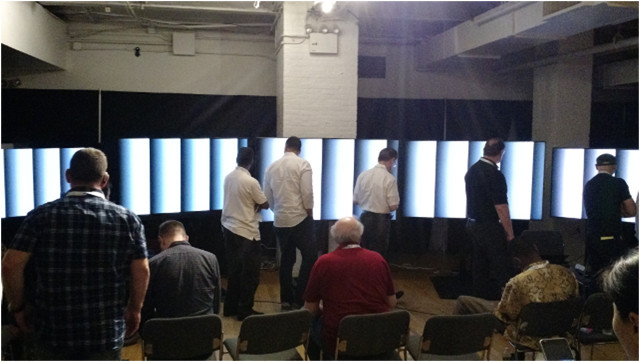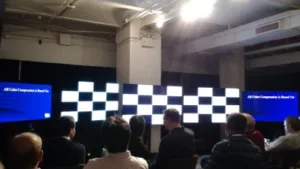Retailer Value Electronics, working with AVPro and ISF founder Joel Silver, offered a series of seminars at CE Week that was billed as a “shoot out” between four UHD HDR TVs. Participants were given information on how to evaluate these displays and then asked to rank them. Unfortunately, the process was way too long, the ranking process flawed and I was never able to stay long enough to see how our group ranked the displays.
The displays that were set up for evaluation included:
- Pioneer Kuro PDP 50” HDTV
- LG’s G6 series 55” OLED 4K HDR TV
- Samsung’s 75” curved KS9800 LCD 4K HDR TV
- Sony’s 70” X940D LCD 4K HDR TV
- Vizio 65” Reference series LCD 4K HDR (Dolby Vision) TV
The Pioneer Kuro display was there as a reference for what Silver described as the “best TV ever made in its time.” The Vizio TV supports HDR, but only the Dolby Vision version and not HDR10, so it was unable to show the HDR test pattern that the LG, Samsung and Sony sets could show (a Dolby Vision version of the test patterns would be needed for this, which was not done).

Silver is a very knowledgeable expert on TV metrology, but the sessions were too long and included many diversions with anecdotes from his career. There was also a lot of basic information on calibration. This is appropriate for those who need it, but it diminished the value for those who just wanted to evaluate the displays. I came in a bit late to arrive at the session and was there for over an hour – and the session was not finished by the time I had to leave for a dinner appointment. As a result, I never got to the point of the session – rating the displays.
What I did witness was a review of basic test patterns and metrology for TVs with patterns displayed in 8-bit SDR and 10-bit HDR (on the LG, Samsung and Sony sets). This included 1080p single pixel grille patterns (not 4K interestingly), black and white pluge diagrams (8-bit for SDR content – not 10-bit for HDR content), 4×4 checkerboard patterns (in SDR and HDR, with the HDR showing a big jump in white luminance).
Silver also measured the white and black parts of the checkerboard with a luminance meter for 4 of the 5 displays. The Kuro PDP measured 1121:1 contrast – state of the art for its time. The LG OLED set measured 20,317:1; the Samsung set was 3650:1 and the Sony set 2154:1. This was done in SDR mode but not repeated in HDR mode, which would have been far more interesting.

Basics of color sub-sampling and luma and Chroma multiburst patterns were explained and shown.
The basics of color temperature, color gamut and white point were explained and a measurement example performed. Results for the five sets were not provided, however. Interestingly, Pete Putman observed a definite green color shift in the OLED displays when viewed off axis. He mentioned this to John Taylor and Tim Alessi of LG who acknowledged the shift, but said they had not noticed this before. Pete is digging into this a little more and will report back if he learns the cause of this shift.
The spectrum differences between LED-LCD TVs and OLED TVs was explained and pointed to as the reason that these displays will look different even when calibrated the same way. It is the difference in the spectral power distribution that is responsible.
The basics of gray scale and the non-linear response of the human eye were also explained and gray ramps were then displayed on the TVs. The differences between 8-bit SDR and 10-bit HDR were briefly touched on as well.
This is when I had to leave so I didn’t see how the rankings were done or how the attendees ranked the displays. However, I read reports from others who witnessed the whole program.
According to these reports, attendees voted on seven picture quality-related categories: black quality, perceived contrast, color accuracy, moving resolution, off-axis performance, screen uniformity, and HDR/WCG (high dynamic range/wide color gamut). Additionally, they voted on the more general “overall day” and “overall night” categories. The HDR/WCG score only accounted for 11 percent of the total vote, even though it’s a major selling point of all the contenders.
AVS Forum reported the following final results:
First place:LGG6 (8.9)
Second Place:SonyX940D (8.0)
Third Place:SamsungKS9800 (7.3)
Fourth Place: VizioRS65-B2 (6.9)

Unlike years past, the ballots from professional reviewers, calibrators, and other industry pros were not tabulated separately from the general audience. Most of the attendees were deemed to be very sophisticated—many were active AVS members—so it was decided to tabulate all ballots together.
This marks the third consecutive year that OLED has taken the “King of TV” crown, with Sony’s X940D taking second place in the shootout. It was number one in the “overall day” category, and scored above the other two full array local dimming (FALD) LCD displays in every category. The Samsung set had an obvious flaw with a large dark blotch in the upper right corner, which probably swayed voting away from it. The Vizio set was hard to judge because no HDR content could be shown on it as this would have to be in the Dolby Vision format.
The lack of good HDR content seemed like a major flaw in this evaluation, it seemed to me, as most content was 709 and done in a dark room (a condition which would favor OLED). – CC

